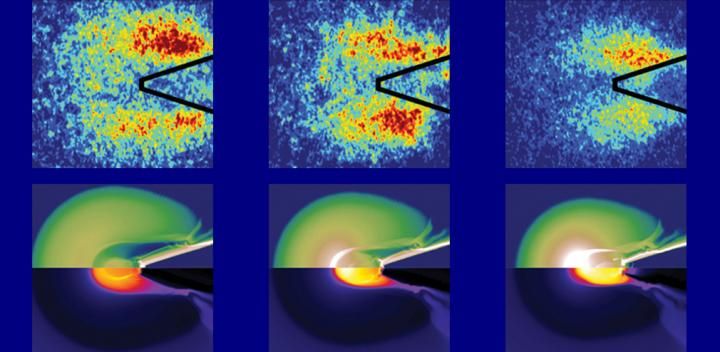Seeing where energy goes may bring scientists closer to realizing nuclear fusion
An international team of researchers has taken a step toward achieving controlled nuclear fusion--a process that powers the Sun and other stars, and has the potential to supply the world with limitless, clean energy.

Visualization of energy flow in fast ignition experiments is made possible by the use of copper tracers and a high-tech X-ray imaging system.
High Energy Density Physics Group, UC San Diego
The team, led by scientists and engineers at the University of California, San Diego and General Atomics, developed a new technique to "see" where energy is delivered during a process called fast ignition, which is an approach to initiate nuclear fusion reactions using a high-intensity laser. Visualizing the energy flow enabled researchers to test different ways to improve energy delivery to the fuel target in their experiments.
Fast ignition involves two stages to start nuclear fusion. First, hundreds of lasers compress the fusion fuel (typically a mix of deuterium and tritium contained in a spherical plastic fuel capsule) to high density. Then, a high-intensity laser delivers energy to rapidly heat (ignite) the compressed fuel. Scientists consider fast ignition a promising approach toward controlled nuclear fusion because it requires less energy than other approaches.
But in order for fast ignition to succeed, scientists need to overcome a big hurdle: how to direct energy from the high-intensity laser into the densest region of the fuel. "This has been a major research challenge since the idea of fast ignition was proposed," said Farhat Beg, professor of mechanical and aerospace engineering and director of the Center for Energy Research at UC San Diego.
To tackle this problem, the team devised a way to see, for the first time, where energy travels when the high-intensity laser hits the fuel target. The technique relies on the use of copper tracers inside the fuel capsule. When the high-intensity laser beam is directed at the compressed fuel target, it generates high-energy electrons that hit the copper tracers and cause them to emit X-rays that scientists can image.
"Before we developed this technique, it was as if we were looking in the dark. Now, we can better understand where energy is being deposited so we can investigate new experimental designs to improve delivery of energy to the fuel," said Christopher McGuffey, assistant project scientist in Beg's High Energy Density Physics Group at the UC San Diego Jacobs School of Engineering and co-author on the paper.
And that's what the team did. After experimenting with different fuel target designs and laser configurations, researchers eventually achieved a record high (up to 7 percent) efficiency of energy delivery from the high-intensity laser to the fuel. This result demonstrates an improvement on efficiency by about a factor of four compared to previous fast ignition experiments, researchers said.
Computer simulations also predicted an energy delivery efficiency as high as 15 percent if the experimental design was scaled up. But this prediction still needs to be tested experimentally, said Beg. "We hope this work opens the door to future attempts to improve fast ignition."
Original publication
Most read news
Other news from the department science

Get the chemical industry in your inbox
By submitting this form you agree that LUMITOS AG will send you the newsletter(s) selected above by email. Your data will not be passed on to third parties. Your data will be stored and processed in accordance with our data protection regulations. LUMITOS may contact you by email for the purpose of advertising or market and opinion surveys. You can revoke your consent at any time without giving reasons to LUMITOS AG, Ernst-Augustin-Str. 2, 12489 Berlin, Germany or by e-mail at revoke@lumitos.com with effect for the future. In addition, each email contains a link to unsubscribe from the corresponding newsletter.


























































